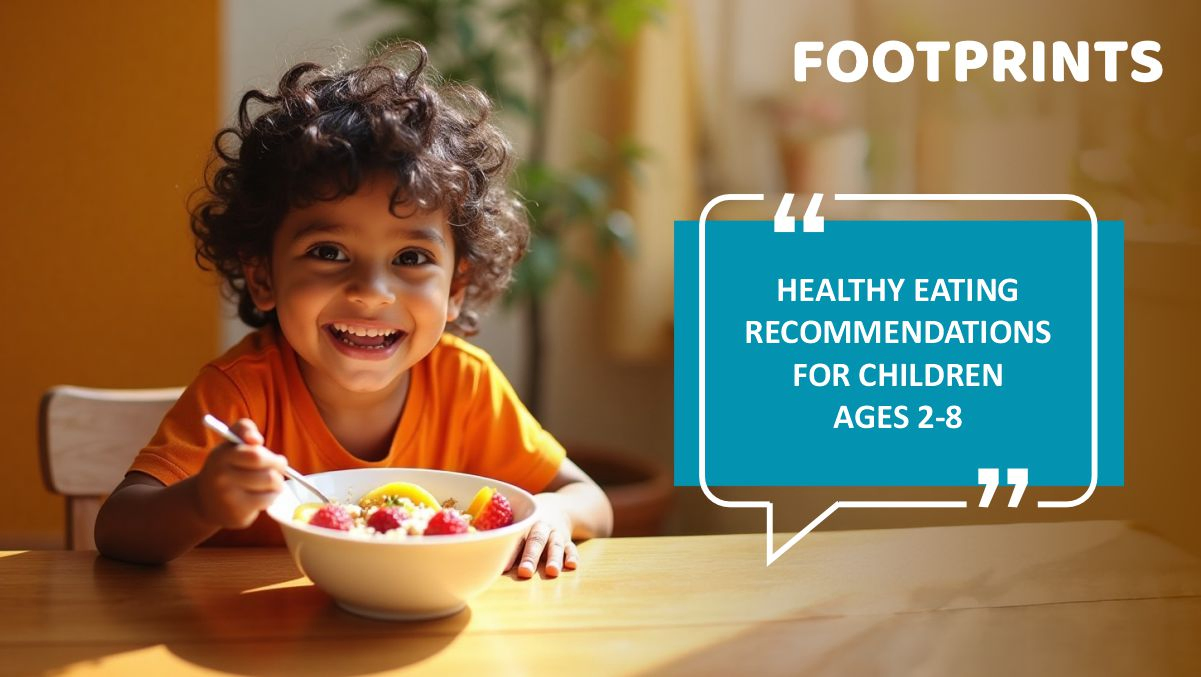

Feeding children aged 2 to 8 isn’t just about calories, it’s about quality. Providing healthy food for children helps them set their tummy preferences and their brains to look out for a balanced and healthy lifestyle, and teaches them some lifelong lessons about the wholesome things to put in their bellies. This crucial developmental window is a golden opportunity to introduce balanced meals and healthy routines that can positively influence their future. Children at this stage are growing quickly. Their bodies need a steady stream of nutrients to support not just physical development but also cognitive growth, immune strength, and emotional well-being. Establishing healthy eating habits early sets the foundation for a lifetime of wellness. Footprints Preschool takes this into account very seriously and helps parents nurture children to the best of their abilities.
Age-Specific Food Planning
A well-planned 2-year-old baby food chart focuses on simple, soft, and nutrient-dense foods. Talking about little ones this tender age, they’re still mastering chewing and swallowing properly. Let’s add foods like soft grains like cooked oats or rice, diced fruit such as bananas, pears, or mangoes, boiled veggies like carrots or potatoes, whole milk is definitely good, and mashed lentils fit into the mix too. Finger foods can help develop fine motor skills. Offer small meals frequently—3 main meals and 2–3 healthy snacks. Avoid foods with added salt or sugar. Make mealtimes stress-free and playful to build a positive association with eating.
4 to 5-Year-Olds
By age four or five, little children start forming strong likes and dislikes. A 4 to 5-year-old child’s food chart should be colorful and well-balanced. Include mild spices, steamed or sautéed vegetables, whole grains like roti or rice, fruits, paneer, curd, and soft meat like chicken or fish. At this stage, encourage them to eat with the family. Offer structured meals and limit snack times to maintain appetite and meal interest. Include one new food weekly to expand their palate.
7-Year-Olds
A balanced diet chart for a 7-year-old child should meet increasing energy demands from school, play, and growth spurts. Key elements in healthy food for children include whole grains (millets, brown rice, whole wheat), proteins (pulses, eggs, lean meat), dairy (milk, yogurt), and a variety of fruits and vegetables. Make meals interactive – let them help with prepping food. Talk about the benefits of each food group. Tell them to tune into what their body’s saying, not to pig out. Include iron-rich foods (like spinach or dates) and vitamin C sources (like oranges or amla) for better nutrient absorption.

Top Choices: Best Foods for Toddler Health
Nutrition is best absorbed through whole foods rather than supplements. The best foods for toddler and child development include:
• Mashed sweet potatoes: High in fibre and beta-carotene.
• Cooked carrots and peas: Soft and vitamin-rich.
• Scrambled eggs: Packed with protein and essential fats.
• Seasonal fruits: Mangoes, apples, berries, and bananas are excellent choices.
• Yoghurt and cheese: Great sources of calcium and probiotics.
• Tofu or paneer: Gentle on digestion and rich in protein.
• Whole grains: Oats, quinoa, millet, and brown rice fuel energy.
• Nut butters (if no allergies): Good source of healthy fats. Offering these in a variety of preparations keeps children engaged and curious about food.
Five Good Eating Habits for Child Wellness
1. Eat as a family: Children model adult behavior. Eating together fosters connection and allows you to lead by example.
2. Rotate fruits, vegetables, grains, and proteins regularly. This keeps meals exciting and nutritionally diverse.
3. Limit processed food: Avoid packaged snacks, sugary drinks, and fast food. Choose homemade alternatives and involve your child in preparation.
4. Encourage drinking water regularly: Water should be the main beverage. Limit juice intake to occasional small servings.
5. Avoid bribing with dessert: Instead, talk about how food helps the body grow, stay strong, and feel good. Teach mindful eating and gratitude for meals.

Instilling a Love for Wholesome Food in Children
Creating a healthy relationship with food starts at home. What little ones like to eat is heavily based on the stuff they see and experience around them. Little eaters learn by seeing and tasting, whether they see their parents lovingly munching on their favourite bites or cooking in the kitchen. Keep meals colorful, cheerful, and interactive. The best healthy tips for parents are to avoid pressuring them to finish everything on their plates. Let your child’s eating food be a joyful experience. Use story-based descriptions (e.g., “carrots help you see like a superhero” and allow small choices (e.g., “Do you want apple slices or a banana with lunch?”. This gives them a sense of autonomy. Introduce new foods slowly and pair them with familiar favourites. Praise effort, not just outcomes. A child who tastes broccoli—even if they don’t love it—is still making progress.
Healthy Eating: A Lasting Investment
The effort you put into your child’s diet today will pay dividends for years to come. From building strong bones and muscles to supporting brain function and emotional resilience, food is a powerful tool. Stay patient and consistent. Celebrate small wins, whether it’s trying a new vegetable or drinking an extra glass of water. When children fall in love with and appreciate healthy meals and proper nutrition, it ends up setting them up to live healthily ever after. They grow up loving to eat foods that are good for them and consequently do great things for their body’s way into later years. By offering the right food, modelling good behavior, and making mealtime enjoyable, you’re not just feeding a child—you’re nurturing a future of wellness, one bite at a time.
Aditya brings over ten years of expertise as a Senior Marketing Strategist. He’s an expert at developing captivating marketing tactics that regularly provide excellent outcomes. His innovative strategies have demonstrated a track record of increasing organizational reach and engagement, showcasing his extensive knowledge of the contemporary marketing landscape.

